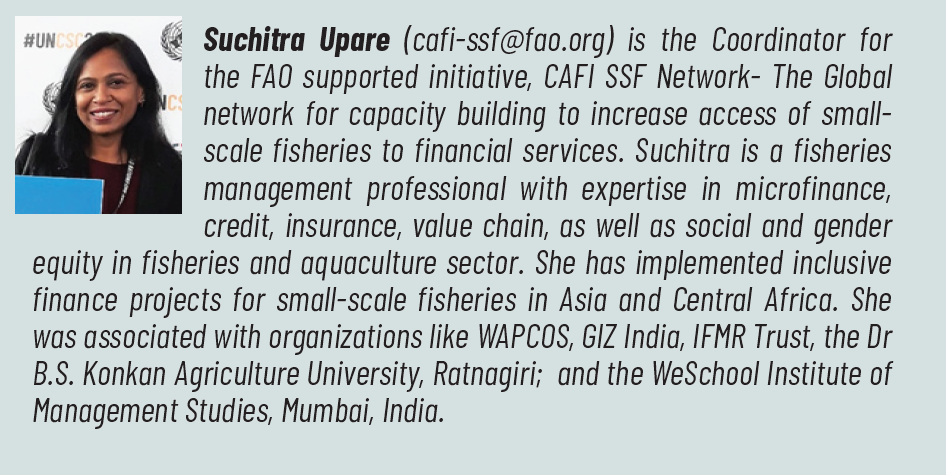Article II 5/2024: FINANCING INNOVATIONS FOR SUSTAINABLE SMALL-SCALE FISHERIES
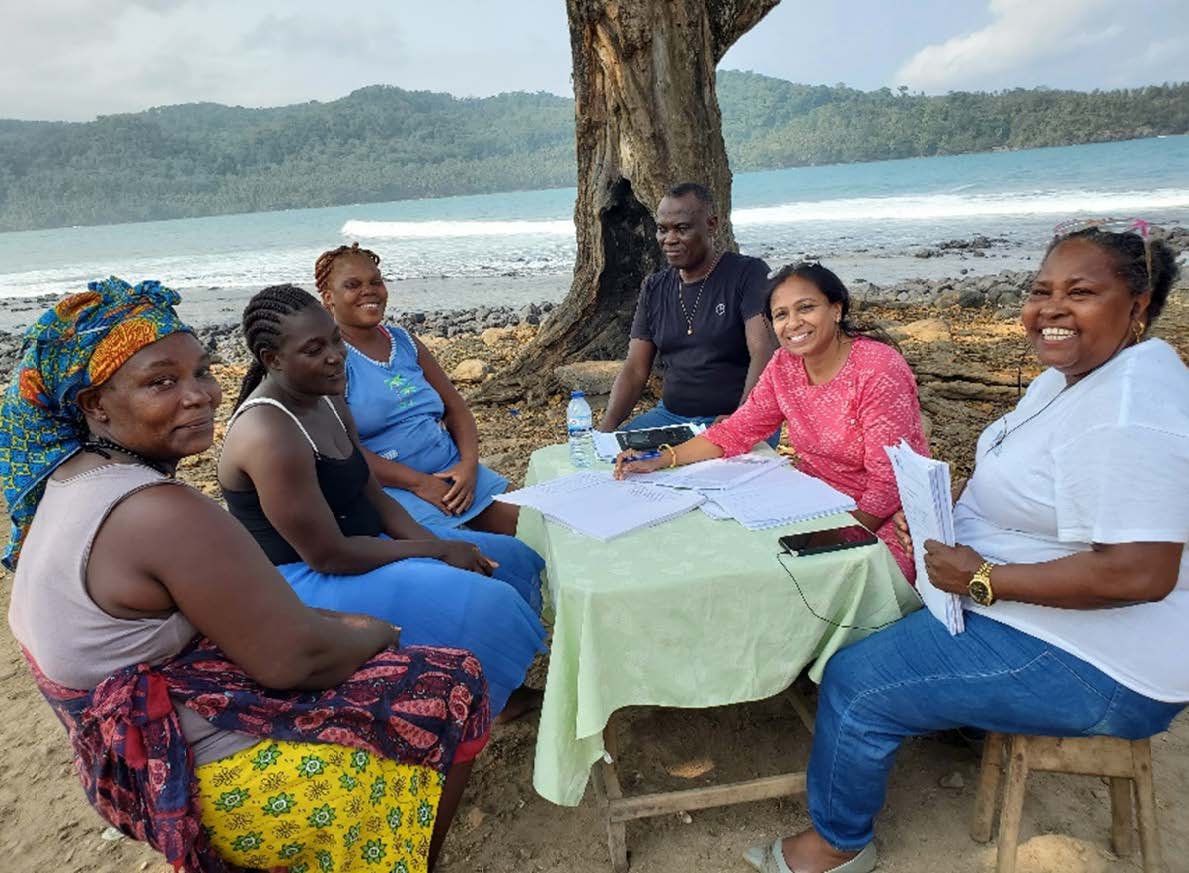
The “Small in Scale and Big in Value” small-scale fisheries (SSF) sector is diverse and dynamic, with 500 million people dependent on it for their livelihood (FAO 2024). This sector utilises labour-intensive harvesting, processing, and distribution technologies, to make the most of marine and inland-water fishery resources through capture and culture fishing practices. They primarily focus on supplying fish and fishery products to local and domestic markets, as well as for subsistence consumption by the fishers themselves. SSFs are generally profitable and play a crucial role in the environmental, economic, and social well-being of many coastal communities, contributing to sustainability.
However, the income from fishing alone is often insufficient to keep households above the poverty line, especially when considering the additional challenges exacerbated due to climate risks faced by SSF communities and sectors in general. One of the major constraints is the lack of access to finance, to support the working capital requirement of SSF. Therefore, it is imperative to introduce various innovative financial instruments that could be implemented to serve the unmet financial needs of the small-scale fisheries sector.
This article is dedicated to 10 years of celebrating the Voluntary Guidelines for Securing Sustainable Small-Scale Fisheries in the Context of Food Security and Poverty Eradication which is the first internationally agreed instrument dedicated entirely to the immensely important – but until recently often neglected – small-scale fisheries sector.
Access to financing is a priority
Meanwhile, 2022 was designated “The International Year of Artisanal Fisheries and Aquaculture (IYAFA 2022)”. Nations began to recognise the importance of SSF as a major contributor to aquatic food systems, and as a part of the solution towards economic, social and environmental sustainability and viability. IYAFA 2024 provided an important platform at a global level to understand how SSF has been an under-served sector. It also confirmed that much needs to be accomplished to attain SDG Target 14.b: “Providing access for small-scale artisanal fisheries to marine resources and markets”.
This implies developing appropriate policies and legislations that take into account the right to access aquatic resources; protect fishing rights; and equity for women participating in various economic activities to sustain and enhance their livelihoods, particularly in post-harvest activities. The FAO’s Blue Transformation Strategy also describes several priority actions which include equitable access to resources and services in order to support small-scale fishers’ access to financing.
Financing gaps in SSF
Financing is critical to the successful and timely fulfilment of SDG 14. It is mainly supplied through philanthropic, private and public funding. According to ODA, philanthropic contribution in 2020 was approximately USD 953 million. The private sector financing data available is limited; it is estimated that approximately USD 7.4 billion was funded during 2012-19, while for the same period, bilateral agencies contributed USD 19.23 billion, and multilateral agencies' contribution was USD 7.9 billion. The Food and Agriculture Organization (FAO) of the United Nations is among the top five with an estimated contribution of 10.6 percent.
Innovative financing instruments
Impact investment is one of the financial instruments which is a major provider of microfinance, and has the potential to create a positive social impact on small-scale fisheries. Impact investment can increase access to credit for small-scale fishery enterprises in return for sustainable fishery practices. The impact can be monitored and measured. This may attract investments from various impact-focused organisations.
Four key criteria guide this type of financing (i) an investor’s intention to have a positive social and environmental impact through investments; (ii) expected to generate financial returns; (iii) expected to give target financial returns ranging from below market rate to risk-adjusted market rate; and (iv) measurement of impact in terms of social and environmental performance and progress of investments by the investor.
According to the Global Impact Investing Network, the investment market is expected to grow by around USD 550 billion (GIIN, 2024). One of the examples cited for this type is investment is the Althelia Sustainable Ocean Fund, which was acquired by the Paris-based asset management company, Mirova; investments are made to protect natural capital, particularly forests and oceans. One of its portfolios is focused on sustainable capture fishery value chain businesses, that can be certified as sustainable. The fund targets impact across social development and livelihoods. It aimed to invest in 15–20 projects with a timeline of eight years by July 2020. The fund commits to invest over USD 132 million through its impact investment to deliver sustainable economic returns, including in fisheries (Mirova, July 2020).
Blended finance is one such financial instrument that uses philanthropic and/or public money to catalyse the deployment of private capital to achieve a positive impact. Public finance can be utilised to pilot innovative schemes and demonstrate their viability, which can lead to subsequently attracting private financing schemes.
Blended finance can be used in two situations: (i) where projects are too small for private finance, they can be funded through public money and collected into a portfolio. This can be refinanced with private money. The portfolio amount collected (public finance) can be re-deployed; and (ii) the second option is where individual projects or companies are considered too risky for private finance; this is where risk reduction can be facilitated by public finance. For example, a diversified portfolio can be created, either by offering to bear the first losses; or returns can be improved by offering financial incentives such as lower interest rates or performance fees. The closest operation example that can be cited is the Meloy Fund for Sustainable Community Fisheries, which is executed by Rare (a conservation non-profit organization), where funds are obtained from the public and private sectors.
Fisheries microfinance investment vehicles (FMIV): Microfinance, traditionally funded by the international investment arm of public development agencies, is increasingly being funded through private investment. Indeed, microfinance has become a leading asset class in the impact investment landscape.
Microfinance investment vehicles (MIVs) – channels for mobilising funds from private investors to local microfinance service providers – can be used to tap into the emerging interest of private equity players in fisheries impact investment. MIVs generally aim to catalyse flows of new sources of private capital towards sustainable fisheries with positive environmental and social impact. They are utilised to incubate businesses in the supply chain with a focus on sustainable practices; therefore, private and return-seeking capital can be used to support sustainable small-scale fisheries enterprises.
For example, a USD 1 million to USD 5 million MIV could provide capital for low-cost improvements in fish processing activities such as icing, packaging technology and cold storage; distribution logistics such as trucks or interim storage depots; and increasing marketing capacity to augment sales and reach buyers of higher-value fish products.
Guarantee fund: Informal economy in Peru is estimated to make up more than 40% of the country’s GDP, and SSF production supports 80% of the nation’s food security. It is estimated that 62% of small-scale fishing fleets within the country operate informally. This leads to multiple challenges faced by SSF, including (i) limited access to financial services; (ii) lack of formal contracts and employment agreements leaves them vulnerable to market fluctuations, compounded with global climate uncertainty. Also, less availability of fish leads to economic uncertainties; and (iii) It also leaves out several fishers who become ineligible to apply for government schemes. This affects not only their business operations but impacts the entire fisher households and pushes them further into marginalisation. A study conducted by UNDP’s Biodiversity Finance Initiative analysed the credit outflow of main financial institutions and found around 95% of financial service providers’ loan portfolio was in the agriculture and livestock sector, while only 5% of loans were provided to the SSF sector. The reasons cited were that the SSF sector was perceived as a high-risk business as compared to land-based business enterprises.
A pilot has been initiated to bridge the financing gap through the Artisanal Fisheries Development Fund, which is a loan guarantee to provide access to formal finance for artisanal or small-scale fisher communities in Peru. The fund is operated through Caja Sullivan, a financial service provider that offers credit and savings services to clients. The mission of this entity is to provide financial inclusion and access to mainstream finance for SSF. The fund will facilitate the provision of collateral required by financial service providers for the provision of loans to fisherfolk cooperatives and individual fishers. The pilot will operate for two years and the outcome expected is to demonstrate that fisher cooperatives and individual small-scale fishers can represent a tangible asset class.
Agency banking model: Usually implemented through bank-appointed agents, the agency banking model facilitates access by small-scale fishers to banking services within their locality or at the doorstep. An example highlighted here is of the Cooperative and Rural Development Bank Plc (CRDB Bank Plc.) whose financing initiative called CRDB Wakala acts as a link between the Bank and its customers in providing normal banking services, including but not limited to, cash deposits and withdrawals.
CRDB Bank has been instrumental in developing micro-entrepreneur and micro-enterprise services that are critical for small-scale fisheries finance. Examples of financing services that serve the needs of SSF communities are as follows:
• Machinga loan: this product is designed for micro-entrepreneurs, recognising that they play an important role in the value chains. A big challenge faced by micro-entrepreneurs is to have sufficient working capital to buy raw materials and supplies to avoid disruptions in their business cycles. The Machinga loan is a shortterm loan that addresses working capital needs via mobile banking; and
• Birashoboka (micro-group loan product): this product is designed to support marginalised and vulnerable populations. The loans are collateral-free. Before loan provision, the groups are trained to maintain records and save together as a group.
CRDB Bank's efforts are noteworthy and exemplary, proof of the fact that large universal banks, if they develop the right tools and advisory services, can address the needs of SSF through innovative financing products and delivery mechanisms.
Fisherfolk Federation Initiatives: as this sustainable microfinance programme has been in operation for more than three decades, it has proven how services designed to serve the needs of SSF can be sustainable. It supports the credit-worthiness of SSF communities with a good repayment schedule. One such example is the South Indian Federation of Fishermen Societies (SIFFS) in India, which introduced a microfinance programme to meet the needs of its members. Despite the perception that credit to fisheries is high-risk lending, SIFFS successfully provides productive-purpose loans to small-scale fishers, using a flexible repayment structure and low-interest spread.
Customised loan products have been developed to suit the needs of smallscale fisheries and fisher households, including owners of motorised and non-motorised small-scale fishing vessels and crew members of smallscale fishing vessels. SIFFS offers larger loans and longer repayment periods than the banks; for example, 36 instalments to be repaid over 42 months with an interest rate of 12%, as well as seasonal loans to be repaid at the end of the fishing season. A simple formula is applied for loan repayment: 10% of the value of the daily fish catch.
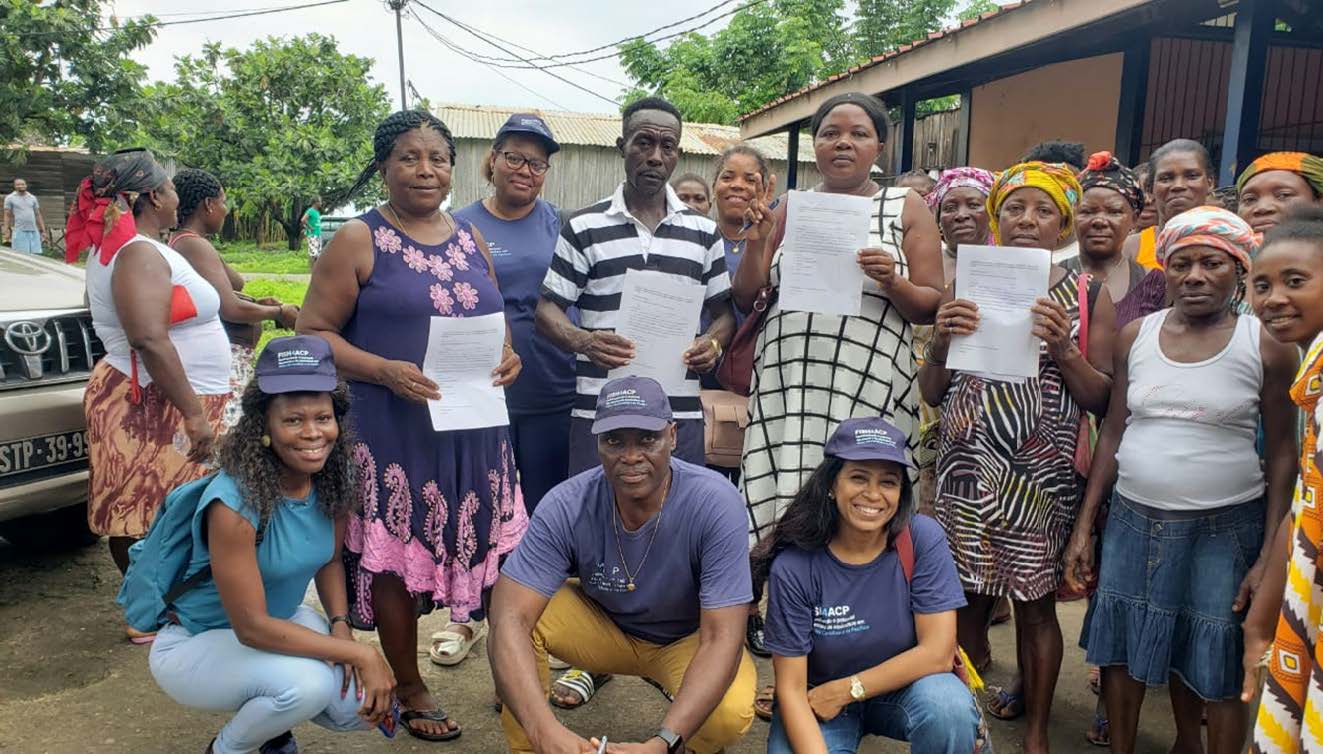
The CAFI SSF Network
There are several fisheries associations in STP; all of them are formally constituted but with low levels of operations. Some exist only in name and are dormant. Most of the associations do not provide members with credit for their fishing operations, but they may focus on providing welfare and social support to cater for school fees, medical needs or funeral expenses. This type of support is provided through non-interest social funds. A value chain financial services market supply/demand study carried out by the global fish value chain development program, FISH4ACP, showed that there is a need for an inclusive finance model for the provision of access to credit by financial institutions. This gap was addressed through the introduction, formation, and establishment of Self-Help Groups (SHGs) in the fishing communities and within existing fisheries associations, by FISH4ACP, with the support of the CAFI SSF Network.
These SHGs are informal, voluntary organisations that are self-managed by a homogeneous group of people who come together to fulfil their financial and community needs. The group members are mainly from the same neighbourhood or adjacent village. Members engage primarily in thrift and credit activities. Each group operates on the principles of mutual help, shared responsibility, and cooperation to achieve individual and joint financial goals, in the immediate or longer term. It consists generally of 10–15 members. A self-help group member base usually does not exceed more than 20 members.
FISH4ACP is an initiative of the Organisation of African, Caribbean and Pacific States (OACPS) aimed at making fisheries and aquaculture value chains in Africa, the Caribbean and the Pacific more productive and sustainable. FISH4ACP is implemented by FAO with funding from the European Union (EU) and the German Federal Ministry for Economic Cooperation and Development (BMZ).
In Sao Tomé and Principe, FISH4ACP works to make the coastal pelagic fisheries more profitable and sustainable to boost food and nutrition security, improve the livelihoods of local fishing communities and safeguard fish stocks for future generations. (The FISH4ACP Sao Tomé country page is:
https://www.fao.org/in-action/fish-4-acp/where-we-work/africa/saotome-and-principe/en/
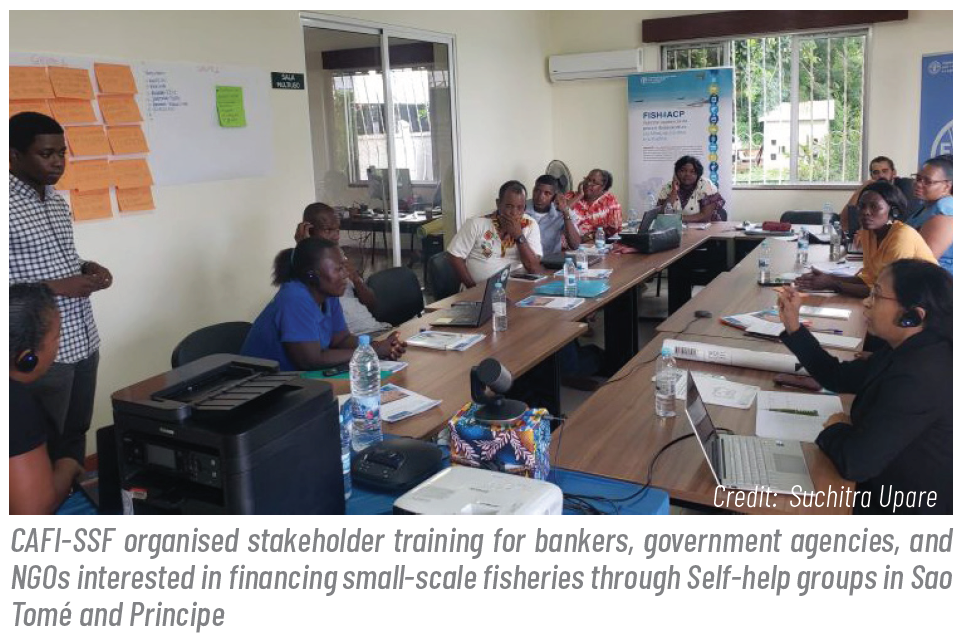
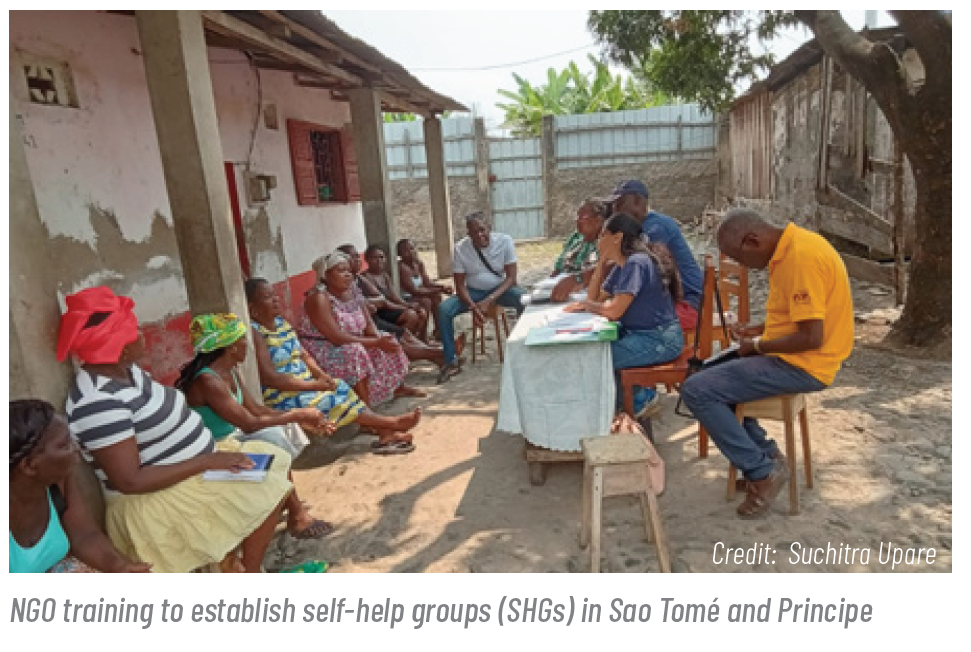
Recommendations
• It should be made clear to beneficiaries, before and even during loan sanction, that finance made available to them is not a government grant, it needs to be returned with interest, within a fixed time duration;
• Loan procedure should be simple and easy to understand for beneficiaries;
• Loan repayment schedule should be prepared considering the nature of the investment, especially taking into account the fish harvesting cycle /type of fishing trips/marketing cycle;
• Loans should be disbursed by financial service providers promptly, based on the capital requirement as well as serving the purpose of the loan required by the small-scale fishers; and
• Appropriate capacity-building of all stakeholders.
Conclusion
References
• World Economic Forum.2022. SDG14 Financing Landscape Scan: Tracking Funds to Realize Sustainable Outcomes for the Ocean, White Paper. June 2022.
• United Nations. 2021. Financing for Sustainable Development Report 2021: Inter-agency Task Force on Financing for Development.
• FAO.2020d. FAO’s Blue Growth Initiative. Blue finance guidance notes: Microfinance for small-scale fisheries. Rome. http://www. fao.org/3/ca8645en/ca8645en.pdf
• FAO. 2020g. FAO’s Blue Growth Initiative. Blue finance guidance notes: Impact investment, Blended finance, Rome. http://www.fao. org/3/ca8740en/CA8740EN.pdf,http://www.fao.org/3/ca8744en/ CA8744EN.pdf
• OECD. 2020. Sustainable Ocean for All: Harnessing the Benefits of Sustainable Ocean Economies for Developing Countries, The Development Dimension, OECD Publishing, Paris, https://doi. org/10.1787/bede6513-en.
